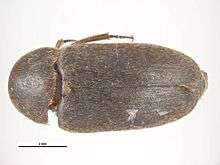Dermestes ater
| Dermestes ater | |
|---|---|
 | |
| Scientific classification | |
| Kingdom: | Animalia |
| Phylum: | Arthropoda |
| Class: | Insecta |
| Order: | Coleoptera |
| Family: | Dermestidae |
| Genus: | Dermestes |
| Species: | D. ater |
| Binomial name | |
| Dermestes ater De Geer, 1774 | |
Dermestes ater is a species of beetle in the family Dermestidae, the skin beetles. It is known commonly as the black larder beetle or incinerator beetle.[1] It is native to North America, but today it is found nearly worldwide. Like several other dermestid beetles, this species is familiar as a common pest of stored products.[1]
Description
The adult beetle is about 7 to 9 millimeters long. It has black or brown elytra and a coating of yellowish hairs. The male can be distinguished from the female by a row of bristles along the abdomen. The larva is white with long dark bristles, its body darkening in color to black, brown, or reddish as it grows. It reaches a maximum length around 14 millimeters.
Life cycle
The female lays 1 to 25 eggs at a time. They are whitish and about 2 millimeters long. The eggs hatch in a few days, depending on temperature. Larval development also depends on temperature, as well as humidity and food availability. Each larva may proceed through six to nine instars, taking 19 to 50 days to grow to maximum size. It then pupates for several days. The adult lives for around 169 days, depending on temperature.[1]
Economic and scientific importance
The beetle attacks many types of stored food and other products. It has been found in cheese, dried fish, leather, copra, silk, wool, milk powder, incinerated waste,[1] hog bristles, dried mushrooms, cacao, and ginger.[2]
It is an occasional predator, feeding on live insects; it is a pest of the sericulture industry because it preys on silkworm pupae, damaging the silk cocoons in the process.[3] It also feeds on housefly (Musca domestica) larvae and pupae in places where both insects congregate, such as poultry houses.[4] The adult may cannibalize larvae and pupae of its own species, and the larvae may eat each other and the eggs.[1] It is also a scavenger of dead animals.[2] It is a pest of museum collections, such as dried insects.[1] It has been found living in and consuming human corpses, so it may play a role in forensic entomology.[5]
The beetle carries several parasites including chicken tapeworms, and are found inhabiting chicken coops where they can spread the parasites to the birds.[6]
References
- 1 2 3 4 5 6 Bujang, N. S. & Kaufman, P. E. Black larder beetle, incinerator beetle, Dermestes ater DeGeer (Insecta: Coleoptera: Dermestidae). Publication #EENY480, University of Florida Institute of Food and Agricultural Sciences (IFAS) Extension. August 2010.
- 1 2 Roth, L. M., & Willis, E. R. (1950). The oviposition of Dermestes ater Degeer, with notes on bionomics under laboratory conditions. American Midland Naturalist 44(2) 427-447.
- ↑ Veer, V., Negi, B. K., & Rao, K. M. (1996). Dermestid beetles and some other insect pests associated with stored silkworm cocoons in India, including a world list of dermestid species found attacking this commodity. Journal of Stored Products Research, 32(1), 69-89.
- ↑ Menezes, L. C., Rossi, M. N., & Reigada, C. (2005). Consequences of refuge for the functional response of Dermestes ater (Coleoptera: Dermestidae) to Musca domestica (Diptera: Muscidae). Population Ecology, 47(3), 213-219.
- ↑ Kumara, T. K., et al. (2009). The infestation of Dermestes ater (De Geer) on a human corpse in Malaysia. Trop Biomed 26(1) 73-79
- ↑ Avancini, R. M., & Ueta, M. T. (1990). Manure breeding insects (Diptera and Coleoptera) responsible for cestoidosis in caged layer hens. Journal of Applied Entomology, 110(1‐5), 307-312.